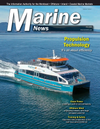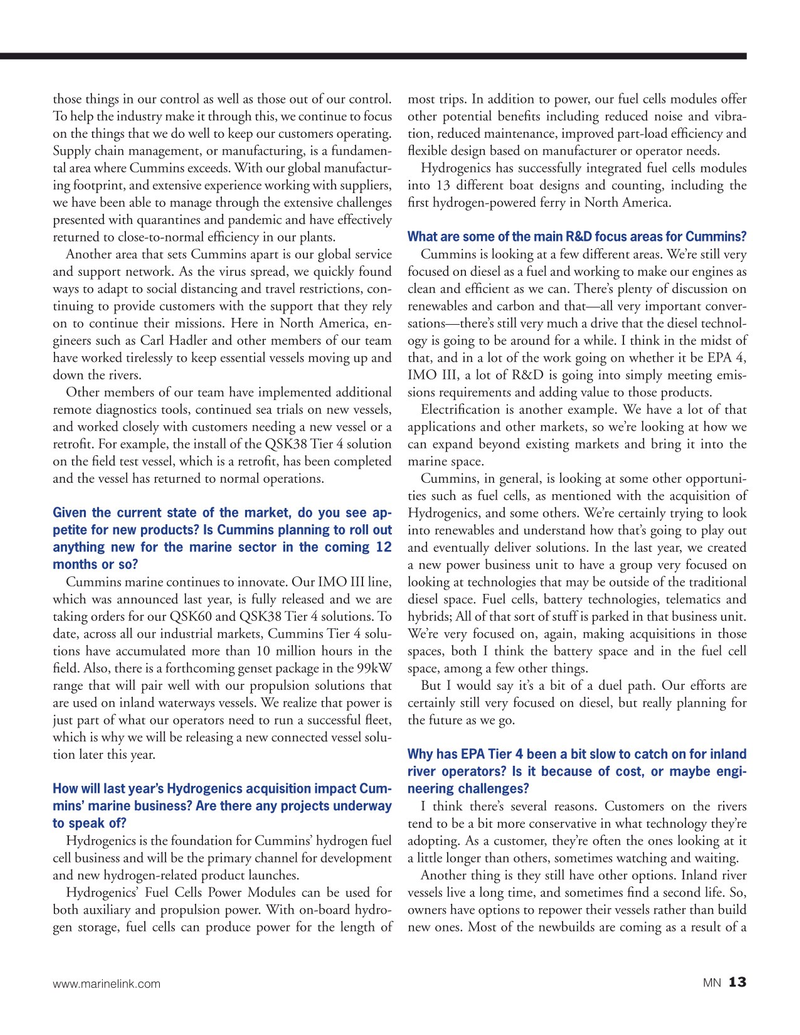
Page 13: of Marine News Magazine (July 2020)
Propulsion Technology
Read this page in Pdf, Flash or Html5 edition of July 2020 Marine News Magazine
those things in our control as well as those out of our control. most trips. In addition to power, our fuel cells modules offer
To help the industry make it through this, we continue to focus other potential bene?ts including reduced noise and vibra- on the things that we do well to keep our customers operating. tion, reduced maintenance, improved part-load ef?ciency and
Supply chain management, or manufacturing, is a fundamen- ?exible design based on manufacturer or operator needs.
tal area where Cummins exceeds. With our global manufactur- Hydrogenics has successfully integrated fuel cells modules ing footprint, and extensive experience working with suppliers, into 13 different boat designs and counting, including the we have been able to manage through the extensive challenges ?rst hydrogen-powered ferry in North America.
presented with quarantines and pandemic and have effectively returned to close-to-normal ef?ciency in our plants.
What are some of the main R&D focus areas for Cummins?
Another area that sets Cummins apart is our global service Cummins is looking at a few different areas. We’re still very and support network. As the virus spread, we quickly found focused on diesel as a fuel and working to make our engines as ways to adapt to social distancing and travel restrictions, con- clean and ef?cient as we can. There’s plenty of discussion on tinuing to provide customers with the support that they rely renewables and carbon and that—all very important conver- on to continue their missions. Here in North America, en- sations—there’s still very much a drive that the diesel technol- gineers such as Carl Hadler and other members of our team ogy is going to be around for a while. I think in the midst of have worked tirelessly to keep essential vessels moving up and that, and in a lot of the work going on whether it be EPA 4, down the rivers. IMO III, a lot of R&D is going into simply meeting emis-
Other members of our team have implemented additional sions requirements and adding value to those products.
remote diagnostics tools, continued sea trials on new vessels, Electri?cation is another example. We have a lot of that and worked closely with customers needing a new vessel or a applications and other markets, so we’re looking at how we retro?t. For example, the install of the QSK38 Tier 4 solution can expand beyond existing markets and bring it into the on the ?eld test vessel, which is a retro?t, has been completed marine space.
and the vessel has returned to normal operations. Cummins, in general, is looking at some other opportuni- ties such as fuel cells, as mentioned with the acquisition of
Hydrogenics, and some others. We’re certainly trying to look
Given the current state of the market, do you see ap- into renewables and understand how that’s going to play out petite for new products? Is Cummins planning to roll out and eventually deliver solutions. In the last year, we created anything new for the marine sector in the coming 12 a new power business unit to have a group very focused on months or so?
Cummins marine continues to innovate. Our IMO III line, looking at technologies that may be outside of the traditional which was announced last year, is fully released and we are diesel space. Fuel cells, battery technologies, telematics and taking orders for our QSK60 and QSK38 Tier 4 solutions. To hybrids; All of that sort of stuff is parked in that business unit. date, across all our industrial markets, Cummins Tier 4 solu- We’re very focused on, again, making acquisitions in those tions have accumulated more than 10 million hours in the spaces, both I think the battery space and in the fuel cell ?eld. Also, there is a forthcoming genset package in the 99kW space, among a few other things. range that will pair well with our propulsion solutions that But I would say it’s a bit of a duel path. Our efforts are are used on inland waterways vessels. We realize that power is certainly still very focused on diesel, but really planning for just part of what our operators need to run a successful ?eet, the future as we go.
which is why we will be releasing a new connected vessel solu- tion later this year.
Why has EPA Tier 4 been a bit slow to catch on for inland river operators? Is it because of cost, or maybe engi-
How will last year’s Hydrogenics acquisition impact Cum- neering challenges?
mins’ marine business? Are there any projects underway
I think there’s several reasons. Customers on the rivers to speak of?
tend to be a bit more conservative in what technology they’re
Hydrogenics is the foundation for Cummins’ hydrogen fuel adopting. As a customer, they’re often the ones looking at it cell business and will be the primary channel for development a little longer than others, sometimes watching and waiting.
and new hydrogen-related product launches. Another thing is they still have other options. Inland river
Hydrogenics’ Fuel Cells Power Modules can be used for vessels live a long time, and sometimes ?nd a second life. So, both auxiliary and propulsion power. With on-board hydro- owners have options to repower their vessels rather than build gen storage, fuel cells can produce power for the length of new ones. Most of the newbuilds are coming as a result of a 13 www.marinelink.com MN

 12
12

 14
14
